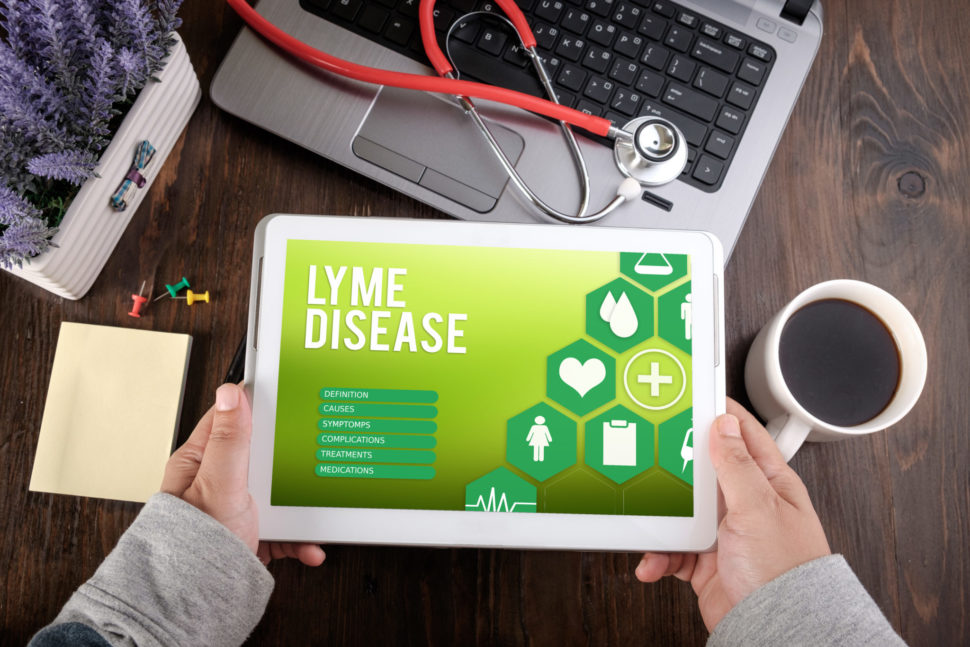In 2018, there really is an app for everything. Now, it really means everything, including Lyme disease.
Smartphone apps can do many things today such as change the color of your techwear fabric. They can (maybe) even help you learn a new language.
But a 13-year old teen suffering from the effects of Lyme disease saw the advantages of a smartphone app beyond fitness tracking, social media, or other service-based functions.
However, the Coupled Natural and Human systems (CNHs) on Lyme disease project also saw a breakthrough with their own smartphone app known as The Tick App.
Is this a case of parallel thought or can they both be useful?
How TickTracker Came to be and What it Does
Olivia Goodreau, diagnosed two years ago, takes 86 pills a day and will have to for the rest of her life. That’s how she has to manage to live with Lyme disease.
As a result of this new reality, she and her family worked to develop a free smartphone app to help spread awareness of all things ticks related.
For those who may not know, ticks are tiny little brown bugs. They can burrow into your skin and bite you, sometimes infecting you with something known as Lyme disease. As with many diseases, a bacteria causes it, as transmitted by the tick.
Untreated or undiagnosed Lyme disease can cause complications with joints, the nervous system, and the heart. And, lucky for us, 2018 has so far been one of the worst years for ticks in recorded history.
The TickTracker app raises awareness of how ticks look and what they do, as well as how to remove a tick if one has latched onto someone. The app launched in July across the globe, available in French, Spanish, and English.
The biggest indicator of infection is a “bullseye” type rash at the bite site. However, not everyone displays this telltale symptom. That means that Lyme disease can go undetected for years — just like Olivia’s case.
Until the TickTracker App, there hadn’t been a smartphone solution for Lyme disease. But, one was in the works before this app’s launch.

The Tick App and Other Smartphone Predecessors
The Tick App wasn’t the first attempt researchers made at a Lyme disease centered smartphone app.
The American Lyme Disease Foundation Inc. (ALDF) launched an iPhone app in March of 2015. However, there are some accounts mentioning the app as early as 2010.
As part of a collaboration with the Yale School of Public Health and the US Centers for Disease Control (CDC), the app intended to boost awareness about ticks and Lyme disease. It also took advantage of crowdsourcing.
This app displayed images of ticks at different stages of life and provided information on precautions to take in the presence of ticks. It also provided instructions on how to remove ticks in a narrated video. Users could also report tick sighting.
The researchers provided the content with help from a variety of contributors.
However, another app emerged after research conducted by the University of Wisconsin-Madison, Columbia University, and CDC Regional Centers.
This free app conducted surveys on the “baseline risk of exposure to ticks”.
Users received weekly or monthly reminders to keep logging events in their “tick diaries”. Essentially, the app crowdsources tick sightings and infection rates. The app also provides information about the ecology and biology of ticks, as well as how to identify ticks and defend against infection and bites.
So that brings the total of tick app to three: The Tick App, TickTracker App, and iLyme (the ALDF app tossed around between 2010 and 2015).
Which app Works Best or…Does it Matter?
The Tick App also works on desktop, making it more accessible to different age groups and income levels. The iLyme doesn’t seem to exist anymore and a search for it yields the TickTracker App as the top Google search result.
Part of that might have to do with the charitable foundation Olivia and her mother helped found known as the LivLyme Foundation.
Whatever the case may be, apps like these are essential as we move into Industry 4.0. They are free to access, easy to use, and informative.
Smartphones, already ubiquitous and powerful, will continue to adapt. So will hardware accessories and, perhaps, even brain-to-computer interfaces. Apps will continue to change, too, and apps like this may become more popular.
But for more smartphone savvy users, the TickTracker app seems to be the most mobile friendly. It has an intuitive interface and familiar layout. It has many similar functions to the ALDF iLyme app including tick sighting reports and information about how to identify, remove, and guard yourself against ticks.
The TickTracker App also offers API integration for those interested.



















Comments (0)
Least Recent